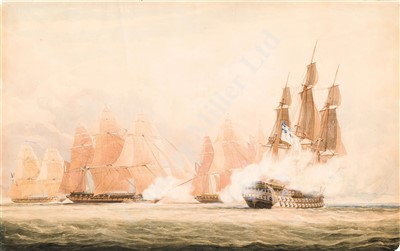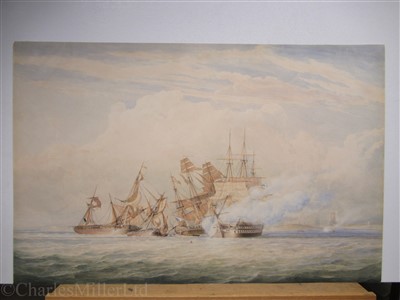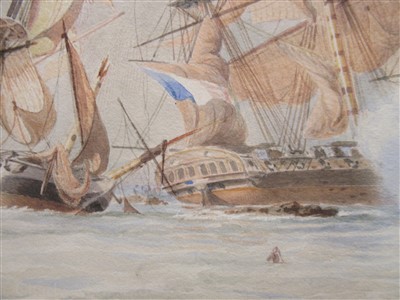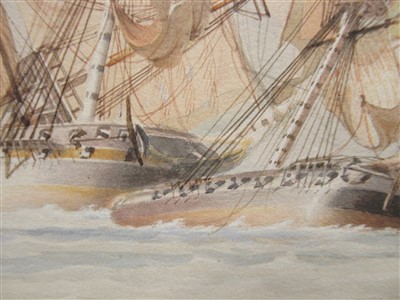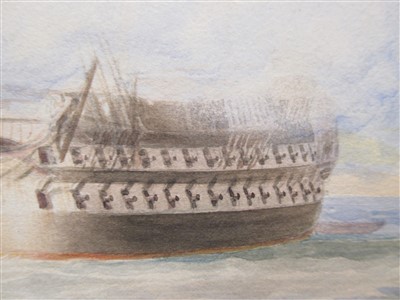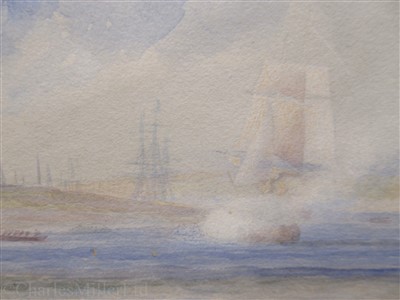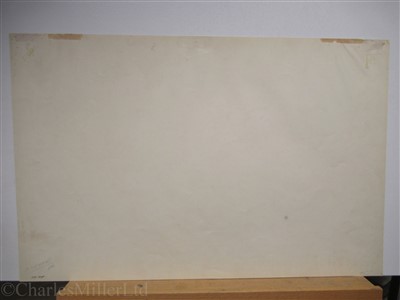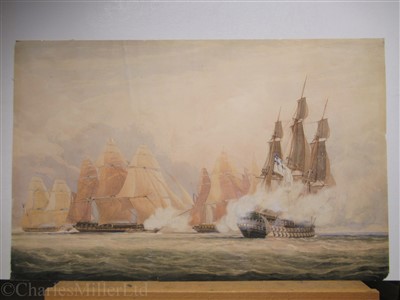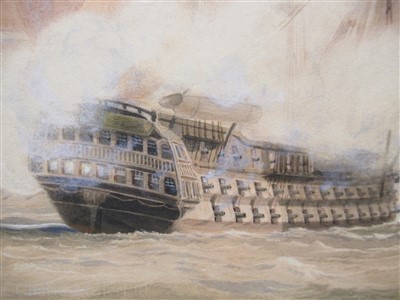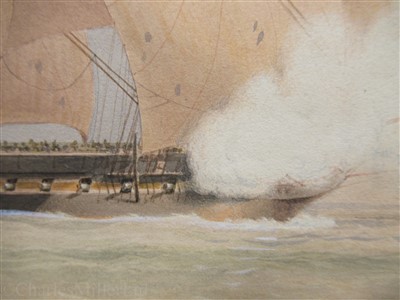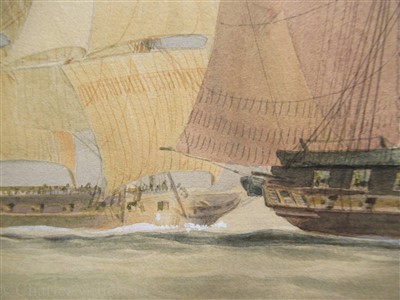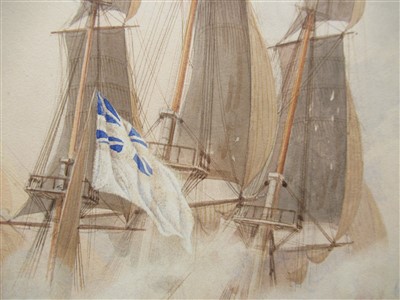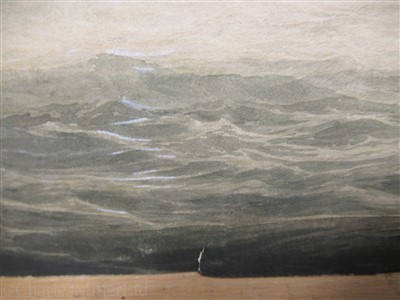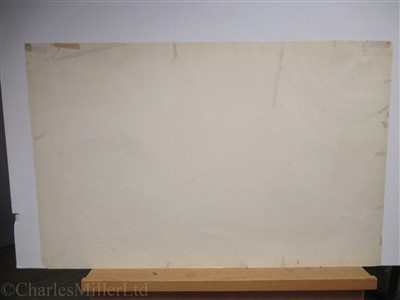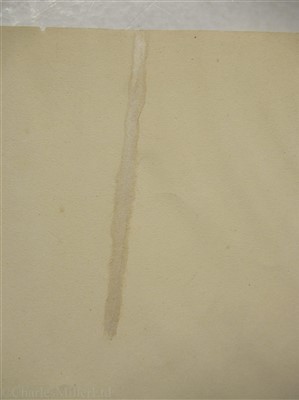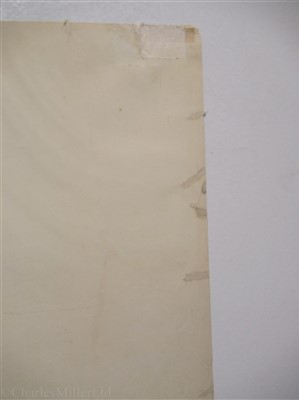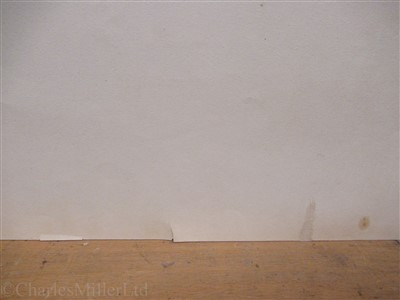5th Nov, 2019 11:00
Maritime and Scientific Models, Instruments & Art ('Superb')
70
[M] NICHOLAS POCOCK (BRITISH, 1740-1821) The engagement between H.M.S. 'Northumberland' and a French squadron
NICHOLAS POCOCK (BRITISH, 1740-1821)
The engagement between H.M.S. 'Northumberland' and a French squadron
Watercolour on wove paper
18¼ x 28¼in. (46.5 x 72cm.)
(2, a pair)
Early in 1812, Rear-Admiral Sir Harry Neale, commanding the Channel Fleet, found himself facing the problem of a small but powerful French squadron, under Commodore Martin le Foretier and consisting of two 40-gun frigates, Arienne and Andromaque, in company with the 16-gun brig Mamelouck, loose on the open sea having broken the blockade and come out of Nantes under orders to disrupt British and other shipping in the Western Approaches..
The 74-gun HMS Northumberland (Captain Hotham) was ordered to cruise off Lorient and await the three French vessels which were expected there. On 22nd May, the enemy vessels were spotted off the Ile de Groix and Hotham ordered the 12-gun brig Growler, which was fortunately close by, to chase them while he sailed around the island to cut off their approach to Lorient. Realising that his original direct approach had been cut off, the French Commodore decided to run between Northumberland and the rocky shore, under the protection of the friendly shore batteries, and thereby attempt to reach his destination. Considering it unsafe to stand his own ship that close to the shore given her size, Hotham followed a parallel course to the French and prepared to engage them with broadside fire from a range of about 400 yards. Hotham and his Sailing Master, Hugh Stewart, had already hatched a daring plan in which they would sail as close as they dared to the Graul Rock, knowing that the French would have to sail between it and their ship, and then destroy them with massive broadsides. Unfortunately there was insufficient depth of water to allow them to pass between the rock and the mainland and any manoeuvring was made more difficult by the fact that the clouds of powder smoke were obscuring the rock from sight. Receiving fire from shore batteries and from the powerful French frigates, Northumberland passed within 200 feet of the rock and the French, as expected, tried to pass inside, between the rock and the mainland. At 15.45, both frigates ran aground and at 15.50, the brig followed. With her sails and rigging damaged, Northumberland was forced to retire out of range to effect repairs to her sails and rigging, leaving the three French vessels stranded by the falling tide. At 16.22, Northumberland returned to the scene to find the three French vessels now hard aground and heeling over. At 16.48, the Mamelouck cut away her mainmast in an attempt to lighten ship and try to escape. At 17.00, Growler arrived on the scene and, being much smaller, closed the range and opened fire with her 18-pdr. carronades. At 17.23, the Arienne's mainmast was shot away by Growler's fire and at 17.28 Northumberland anchored in six and a half fathoms of water and opened fire on the three French vessels with her starboard broadside. Hotham had chosen his position well: his ship was out of range of all but one of the shore batteries and the enemy vessels were helpless. At 17.55, the Andromaque caught fire and five minutes later, her fore-topmast fell and her crew were seen to abandon ship in the boats. By now the flames were spreading fast and at 18.45, the Andromaque's main and mizzen masts fell. At 18.49, the tide was fully out, the Andromaque was completely engulfed in flames and the other ship's bottoms were so badly damaged that they would fill with water when the tide came in. Captain Hotham decided that the time had come to leave the scene, so Northumberland got under way and moved out of range of the one shore battery which could fire on her. All the while, Northumberland had been coming under fire from this shore battery and it had done some damage and caused casualties aboard her. Four of her seamen and one of her Royal Marines had been killed and Lieutenant William Fletcher, three Petty Officers, 19 seamen and five Royal Marines had been wounded. When Northumberland ceased fire, Growler closed the range again and opened fire in order to prevent the French crews from returning to their vessels. At 20.00, the Andromaque blew up and was totally destroyed. At 22.00, the Arienne was seen to be on fire and by 23.30 was engulfed in flames. Mamelouck by this time was lying on her side and was also on fire. At 02.30 the following day, Arienne blew up and later that day, Mamelouck was also destroyed by an explosion.
The first painting depicts H.M.S. Northumberland at the beginning of the engagement, intercepting the French frigates Arienne and Andromaque and the brig Mamelouck as they tried to cut between the Northumberland and the rocky shore with Northumberland opening up broadsides against the French vessels.
The second painting shows the engagement at about 16.30. The three French vessels have run aground on Graul Rock. Arienne's mainmast has been shot away (far left), and the brig Mamelouck (center) is lying on her side. Northumberland has returned from making repairs and is shown at anchor whilst firing her starboard broadsides.
Sold for £6,820
Estimated at £2,000 - £3,000
(inc. buyer's premium of 24%)
Condition Report
Early action: Repaired 5in. tear top left; Edges slightly nibbled; time staining; Late action: Creasing top left.
We are pleased to provide you with a general report of the condition of this property. Since we are not professional conservators or restorers, we urge you to consult with a restorer or conservator of your choice who will be better able to provide a detailed, professional report. Prospective buyers should inspect each lot to satisfy themselves as to condition and must understand that any statement made by Charles Miller Ltd is merely a subjective, qualified opinion. Prospective buyers should also refer to any Important Notices regarding this sale, which are printed in the Sale Catalogue. NOTWITHSTANDING THIS REPORT OR ANY DISCUSSIONS CONCERNING A LOT, ALL LOTS ARE OFFERED AND SOLD “AS IS” IN ACCORDANCE WITH THE CONDITIONS OF BUSINESS PRINTED IN THE SALE CATALOGUE.
NICHOLAS POCOCK (BRITISH, 1740-1821)
The engagement between H.M.S. 'Northumberland' and a French squadron
Watercolour on wove paper
18¼ x 28¼in. (46.5 x 72cm.)
(2, a pair)
Early in 1812, Rear-Admiral Sir Harry Neale, commanding the Channel Fleet, found himself facing the problem of a small but powerful French squadron, under Commodore Martin le Foretier and consisting of two 40-gun frigates, Arienne and Andromaque, in company with the 16-gun brig Mamelouck, loose on the open sea having broken the blockade and come out of Nantes under orders to disrupt British and other shipping in the Western Approaches..
The 74-gun HMS Northumberland (Captain Hotham) was ordered to cruise off Lorient and await the three French vessels which were expected there. On 22nd May, the enemy vessels were spotted off the Ile de Groix and Hotham ordered the 12-gun brig Growler, which was fortunately close by, to chase them while he sailed around the island to cut off their approach to Lorient. Realising that his original direct approach had been cut off, the French Commodore decided to run between Northumberland and the rocky shore, under the protection of the friendly shore batteries, and thereby attempt to reach his destination. Considering it unsafe to stand his own ship that close to the shore given her size, Hotham followed a parallel course to the French and prepared to engage them with broadside fire from a range of about 400 yards. Hotham and his Sailing Master, Hugh Stewart, had already hatched a daring plan in which they would sail as close as they dared to the Graul Rock, knowing that the French would have to sail between it and their ship, and then destroy them with massive broadsides. Unfortunately there was insufficient depth of water to allow them to pass between the rock and the mainland and any manoeuvring was made more difficult by the fact that the clouds of powder smoke were obscuring the rock from sight. Receiving fire from shore batteries and from the powerful French frigates, Northumberland passed within 200 feet of the rock and the French, as expected, tried to pass inside, between the rock and the mainland. At 15.45, both frigates ran aground and at 15.50, the brig followed. With her sails and rigging damaged, Northumberland was forced to retire out of range to effect repairs to her sails and rigging, leaving the three French vessels stranded by the falling tide. At 16.22, Northumberland returned to the scene to find the three French vessels now hard aground and heeling over. At 16.48, the Mamelouck cut away her mainmast in an attempt to lighten ship and try to escape. At 17.00, Growler arrived on the scene and, being much smaller, closed the range and opened fire with her 18-pdr. carronades. At 17.23, the Arienne's mainmast was shot away by Growler's fire and at 17.28 Northumberland anchored in six and a half fathoms of water and opened fire on the three French vessels with her starboard broadside. Hotham had chosen his position well: his ship was out of range of all but one of the shore batteries and the enemy vessels were helpless. At 17.55, the Andromaque caught fire and five minutes later, her fore-topmast fell and her crew were seen to abandon ship in the boats. By now the flames were spreading fast and at 18.45, the Andromaque's main and mizzen masts fell. At 18.49, the tide was fully out, the Andromaque was completely engulfed in flames and the other ship's bottoms were so badly damaged that they would fill with water when the tide came in. Captain Hotham decided that the time had come to leave the scene, so Northumberland got under way and moved out of range of the one shore battery which could fire on her. All the while, Northumberland had been coming under fire from this shore battery and it had done some damage and caused casualties aboard her. Four of her seamen and one of her Royal Marines had been killed and Lieutenant William Fletcher, three Petty Officers, 19 seamen and five Royal Marines had been wounded. When Northumberland ceased fire, Growler closed the range again and opened fire in order to prevent the French crews from returning to their vessels. At 20.00, the Andromaque blew up and was totally destroyed. At 22.00, the Arienne was seen to be on fire and by 23.30 was engulfed in flames. Mamelouck by this time was lying on her side and was also on fire. At 02.30 the following day, Arienne blew up and later that day, Mamelouck was also destroyed by an explosion.
The first painting depicts H.M.S. Northumberland at the beginning of the engagement, intercepting the French frigates Arienne and Andromaque and the brig Mamelouck as they tried to cut between the Northumberland and the rocky shore with Northumberland opening up broadsides against the French vessels.
The second painting shows the engagement at about 16.30. The three French vessels have run aground on Graul Rock. Arienne's mainmast has been shot away (far left), and the brig Mamelouck (center) is lying on her side. Northumberland has returned from making repairs and is shown at anchor whilst firing her starboard broadsides.
Auction: Maritime and Scientific Models, Instruments & Art ('Superb'), 5th Nov, 2019
Download a Bid Form here
Main view and sale venue:
Olympia Auctions
25 Blythe Road
London
W14 0PD
Large object view
6 Imperial Studios
3-11 Imperial Road
London
SW6 2AG
Viewing
Saturday, 2nd November
(12pm-4pm)
Sunday, 3rd November
(12pm-4pm)
Monday, 4th November
(10am-5pm)
Tuesday, 5th November
(10am-11am)

